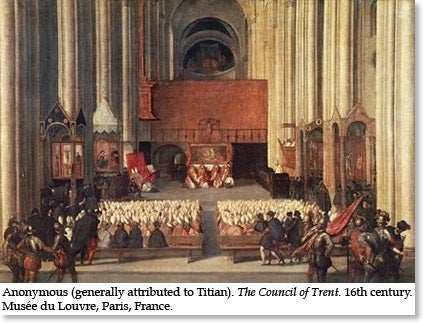
The Counter-Reformation played a major role in defining the role and status of Italian women during the sixteenth century. Women were widely viewed as emblems of Catholic morality, serving primarily as matriarchs of the domestic household. They were instructed and expected to become devoted mothers, and to rear and raise their children as proper Christians. Religious and social changes gradually turned women’s education into a Christian training in obedient wifehood and devout motherhood. These major objectives are emphasized in much of Counter-Reformatory literature, particularly women’s acquisition of strong religious morals aimed at preserving chastity until matrimony as well as the pursuit of the practical skills of “preserving” and managing their husbands’ property and wealth. Little to no value was placed upon the pursuit of knowledge for aesthetic and intellectual purposes. Literate women could even be suspected of witchcraft since popular opinion endowed the written word with “magic powers.” Women were forced to suppress their individual needs and desires to their husbands, all in the name of rationality and civic decorum.
It is not surprising that men exclusively dictated the societal expectations of women. Six of the most significant traits prescribed by men include: Chastity, Silence, Modesty, Reticence, Sobriety, and Obedience. The protection of a woman’s chastity was vitally important, especially for younger women. In some pamphlets, parents were even advised to prevent their daughters from participating in any forms of recreation that could potentially threaten their proper moral upbringing. Domestic crafts such as sewing and weaving were recommended, “to keep young girls’ minds away from sinful thoughts or avoid any other danger of extreme boredom” (Price, 43). Because of these guidelines, women were denied freedom of mind and body, and their identities were confined within their own domestic fortresses.
Counter-Reformatory literature catalyzed the dispersal of these ideals to the Italian population. These works depicted the lives of female saints and virtuous women in an effort to inspire women to imitate them. A total of 2,626 books or pamphlets written between 1471 and 1700 in the vernacular addressed female concerns, with over one thousand printed by 1600.
Venice’s unique social and political environment enabled women to find alternate ways of coping with the strict tenets outlined by the Counter-Reformation; however, many of these strict ideals still strongly impacted the lives of Venetian women during the sixteenth century. Venice’s cosmopolitan, fun-loving and dynamic atmosphere is largely dependent on the Venetian women who lent their beauty, charm, elegance, and sex appeal to honor the city. The celebrated practice of courtesanship supplied the island-republic with an exotic flare that set Venice apart from many other European cities. Furthermore, Venice’s widely diverse population cultivated a broader-minded and more tolerant society that granted women alternate means of establishing themselves. As a whole, however, women still played a relatively ambiguous role in Venetian society of this time: although present everywhere, they were not publicly acknowledged or appreciated.
The patriarchal oligarchy governing Venice denied any political rights to women, and instead relegated them to the private confines of their homes and neighborhoods. Regardless of this opposition, however, women still managed to exert some influence on economic and social relations through the acquisition of dowries and management of the family’s wealth and income. A good deal of the difference between men’s and women’s legal status derived from the patrilineal system of descent and succession. For example, a young woman’s only claim upon the family patrimony was her dowry. A married, and thus dowered, daughter or a man who died intestate had no further claim on his estate. A woman’s dowry was her entire inheritance.
Women were able to find diverse means of contributing to society outside of the home. Women of the lower class kept the city’s working industries alive through artisan and trade-craft practices, while women of the nobility and upper class served as catalysts and donors in the maintenance of charitable hospices, which assured the welfare of hundreds of unfortunate people. Despite political and societal opposition, women continued to aid in Venice’s development as contributing members of society.